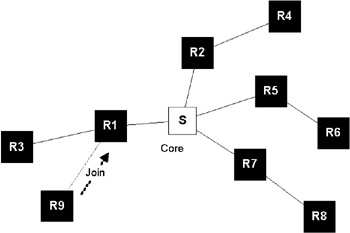4.6 Multicast routing with CBT
|
|
4.6 Multicast routing with CBT
4.6.1 Operation
Core-Based Trees (CBT) is a slimmed-down sparse-mode multicast routing protocol, optimized to support multicast applications such as distributed video gaming and distributed interactive simulation. These applications tend to have many active senders within a single multicast group. Conventional multicast routing protocols (DVMRP or MOSPF) construct a shortest-path tree for each (s, g) pair, meaning that the amount of multicast state information maintained by individual routers is significant. The CBT protocol constructs a single tree that is shared by all members of the group, greatly simplifying the protocols and processes involved.
At the heart of a CBT shared tree is a core router, which is used to build the tree. Routers join the tree by sending a join message to the core. When the core receives a join request, it returns an acknowledgment over the reverse path, forming a new branch of the tree. Join messages need not reach the core before being acknowledged; if the message is intercepted by a router already in the tree (a so-called on-tree router), that router terminates the join and acknowledges it locally. The originating router is then grafted onto the shared tree (see Figure 4.11). In this figure when router R9 wishes to join the tree, it sends a join message back to the core along its reverse path. This message is intercepted by the on-tree router R1, and so the graft can be performed locally, without involving the core.

Figure 4.11: Example CBT topology.
4.6.2 Design issues
CBT is relatively straightforward in design. However, because of the simplicity in the tree construction, CBT aggregates traffic onto a smaller subset of links than would be used for traditional source-based trees, resulting in a large concentration of traffic around the core. This can lead to congestion problems, so some implementations of CBT support the use of load sharing using multiple cores. To date CBT has not been significantly deployed. For further information on CBT the interested reader should refer to [22, 23].
|
|